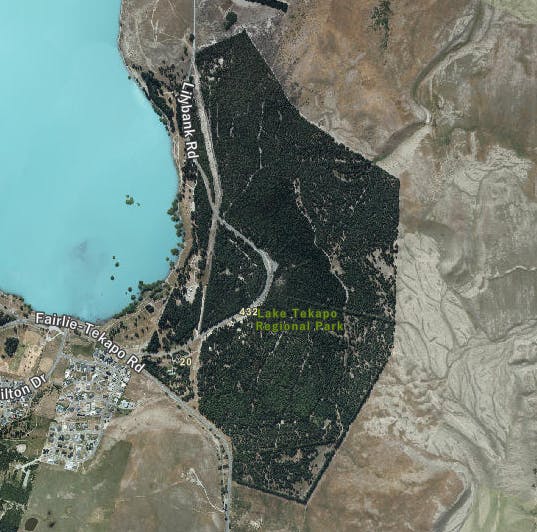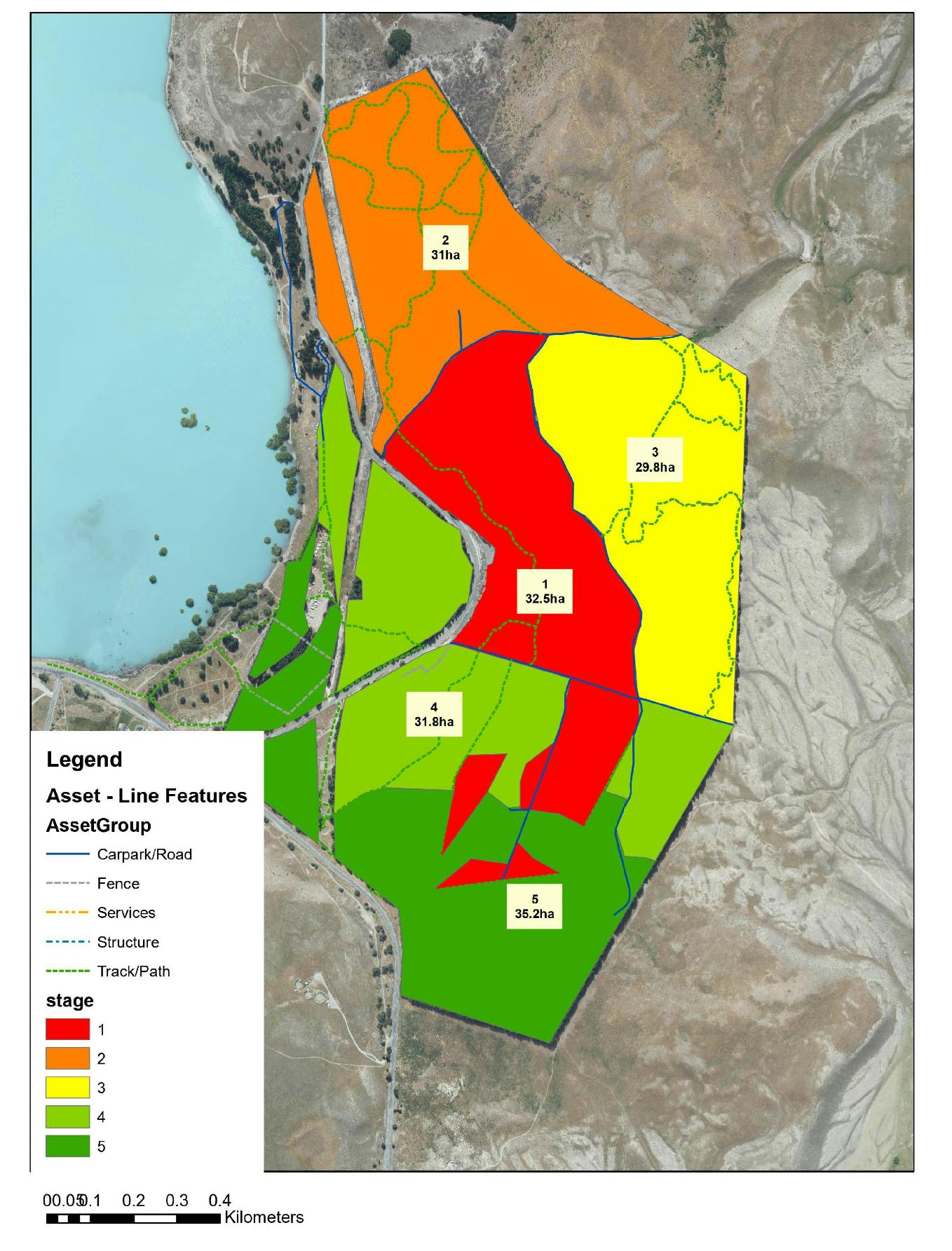Replanting Lake Tekapo/Takapō Regional Park
Have your say about the future of the park
We are planning to remove trees from Lake Tekapo/Takapō Regional Park in five stages over the next 20+ years. We will replant the forest with a mix of exotic and native trees and shrubs.
Why we're replanting
Almost all the trees in Lake Tekapo/Takapō Regional Park are conifers listed as pest species in the Canterbury Regional Pest Management Plan (CRPMP). These trees are prone to producing wilding conifers, also known as wilding pines. Removing wilding conifers costs taxpayers millions of dollars each year. You can find out more about the wilding conifer problem at the Prevent the Spread website
As the managers of Lake Tekapo/Takapō Regional Park, we at Environment Canterbury are responsible for removing these pest species under the CRPMP regulations.
We know the park is valued by the local community and visitors to Takapō, as it provides opportunities to walk, mountain bike, go orienteering and have a picnic, all in a sheltered forest. By removing the wilding conifers in five stages and replanting the forest with exotic and native trees and shrubs, we will protect these recreation opportunities and maintain soil conservation values.
Working in partnership with Te Rūnanga o Arowhenua, who are mana whenua for Takapō, we created a replanting plan that reintroduces native plants to the park and enhances the area's biodiversity.
To stay informed about the project, please enter your email address and click on the "subscribe" button on the righthand side of the page.
Have your say about the future of the park
We are planning to remove trees from Lake Tekapo/Takapō Regional Park in five stages over the next 20+ years. We will replant the forest with a mix of exotic and native trees and shrubs.
Why we're replanting
Almost all the trees in Lake Tekapo/Takapō Regional Park are conifers listed as pest species in the Canterbury Regional Pest Management Plan (CRPMP). These trees are prone to producing wilding conifers, also known as wilding pines. Removing wilding conifers costs taxpayers millions of dollars each year. You can find out more about the wilding conifer problem at the Prevent the Spread website
As the managers of Lake Tekapo/Takapō Regional Park, we at Environment Canterbury are responsible for removing these pest species under the CRPMP regulations.
We know the park is valued by the local community and visitors to Takapō, as it provides opportunities to walk, mountain bike, go orienteering and have a picnic, all in a sheltered forest. By removing the wilding conifers in five stages and replanting the forest with exotic and native trees and shrubs, we will protect these recreation opportunities and maintain soil conservation values.
Working in partnership with Te Rūnanga o Arowhenua, who are mana whenua for Takapō, we created a replanting plan that reintroduces native plants to the park and enhances the area's biodiversity.
To stay informed about the project, please enter your email address and click on the "subscribe" button on the righthand side of the page.
Questions & Answers
Ask your questions here. We will get back to you with an answer as soon as possible. We aim to answer all questions within two business days.
-
Thank you for the reply. As far as I understand, the Mt. Cook Road project will not be replanted. My question was: has there anything been undertaken: clearfelling/replanting the size, location etc. comparable to the LTK project? Where? When? Annual management costs of wilding pine control around the LTK Rec. Park? When/where will be the summary of submissions be made public?
Tekaponian asked over 2 years agoKia ora and thanks for your enquiry.
We're not aware of other examples of similar scaled harvest and replanting on council land in the Mackenzie District.
In reply to your question about annual management costs of wilding pine control around the LTK Rec. Park:The current budget set aside for the management of wilding conifers spreading from the regional park is set at $10,000 annually. This allows Environment Canterbury's Parks and Forests team to clear regenerating pest pines out to 500m from the park perimeter. We are currently working with adjacent landholders and reviewing if this figure is adequate moving forward to mitigate wider spread onto their properties.A summary of the feedback and questions we’ve received is due to be published on the Have Your Say page by 14 April.
#replanting #wildingconifers #feedbacksummary#replanting #wildingconifers #feedbacksummary -
I could not find answers to some of my previous questions e.g.; has anything of this scale been undertaken previously in similar location etc.? Further: will the submissions be published? Looking at aerial photos on ECan website; there is NO spread of trees outside the boundaries. (Photos dating back to 1954). I was in the believe, that this land belongs to Canterbury and ECan is tasked to look after it for the people of Canterbury. (ECan is actually not the landowner). Could you please clarify the legal situation? Setting the pest list: is there ONE pest list for the whole of Canterbury? Are there local adaptions/exemptions? Who is making the pest list? And is/was there any public involvement?
Tekaponian asked almost 3 years agoI could not find answers to some of my previous questions e.g.; has anything of this scale been undertaken previously in similar location etc.?
In the region, the majority of dense stand control where we have completed mechanical removal, like intended with Takapō Regional Park, would range between 20-100 ha per site. A larger example, however, is the Mt Cook Road project that has been running for about three years, and involved over 450 ha in three main properties.
Further: will the submissions be published?
The survey responses will not be published, but we are taking all responses into consideration in our planning for the project. We will publish a report summarising the feedback received (and our responses to that feedback) on this Have Your Say webpage. We are also answering all questions publicly on this page.
Looking at aerial photos on ECan website; there is NO spread of trees outside the boundaries. (Photos dating back to 1954).
Environment Canterbury's Parks and Forests Section completes annual maintenance in the park, including removal of regenerating seedlings out to approximately 500m from the park perimeter. Beyond that distance, the national programme conducts physical and chemical removal of pest species. We are dealing with pest species regenerating following wind-distributed seeding out to 10kms. It is likely you are not seeing widespread regeneration because of the active mitigation programme.
I was in the believe, that this land belongs to Canterbury and ECan is tasked to look after it for the people of Canterbury. (ECan is actually not the landowner). Could you please clarify the legal situation? (SIC)
The park comprises three parcels that are vested in Environment Canterbury for soil conservation and river protection purposes. This effectively makes it Environment Canterbury land for management and care – including control of pest species and replanting to ensure it is maintained fit for designated purpose. The fourth parcel along the waterfront is leased by Environment Canterbury and managed on behalf of LINZ. We have liaised with LINZ to ensure we concurrently manage removal of pest species within their space.
Setting the pest list: is there ONE pest list for the whole of Canterbury? Are there local adaptions/exemptions? Who is making the pest list? And is/was there any public involvement?
There are six declared pest species in the Canterbury Regional Pest Management Plan (CRMP) — contorta, Corsican, Scots, mountain and dwarf mountain pines and larch. These were determined with stakeholder consultation based on species' evidential invasiveness in regional properties and their commercial value. All conifers have potential for invasiveness so they can all be regarded as ‘pest agents’ and identified in the CRMP, however, target species are determined by region. In the case of Lake Takapō, larch – which from your previous correspondence is your species of concern, is a target species for removal.
#wildingconifers #crmp #larch#wildingconifers #crmp #larch -
Are stations near the regional park e.g. sawdon and mt hay having issues with pine control due to spread from the regional park?
Justin asked almost 3 years agoThanks for your question. Pest tree seeds can travel many kilometres on the wind, so neighbouring properties are likely to have wilding conifers originating from the park. We are working directly with nearby landowners to mitigate the spread of wilding conifers on their properties.
#wildingconifers #wildingpines #neighbours#wildingconifers #wildingpines #neighbours -
In the consultation meeting held at Tekapo on the evening of the 21 Feb, it was mentioned that replanted exotics would be planted at a density of 1000 trees per hector, which was said to be at a similar density to the existing forest. A lesser density, more open, forest would allow more light to reach the ground and foster growth of grasses etc as well as posing a significantly less fire risk.
michi.speck asked almost 3 years agoThanks for your question. The forest will initially be planted at the density of 1,000 trees per hectare to ensure the best survival and growth of the new exotic forest. When the trees are around 10 years old, we will thin them to a density of 500 trees per hectare to reduce the risk of fire and disease spread. We will also consider pruning the lower branches of the trees to further reduce fire risk.
#replanting #density #exotics#replanting #density #exotics -
Why are open questions asked on this survey not shown on this page? It seems that only answered questions are shown?
michi.speck asked almost 3 years agoKia ora Michi, thanks for your enquiry. We make the questions visible on the site when we reply to them. Your other questions will show up on the site when we have replies for each of them.
-
Will the dog park stay open?
almost 3 years agoThe dog park will be affected during stage five of the harvest. Based on the current plan, stage five of the harvest will happen in approximately mid-2043. At this time, the dog park will be closed for a maximum of three months to keep you and your dog safe during harvest operations. The dog park is an area which we have identified as priority area for the community, so we will work hard to get this area back up and running for you to enjoy as soon as we possibly can.
-
Can we still use the bike tracks when the trees are being taken down?
almost 3 years agoYes, because we are harvesting over five stages we are able to retain the majority of recreational trails throughout the regional park. However, you can expect to experience some detours. Detours will be clearly marked out on the trails and are there to keep you a safe distance from all harvest operations. We know how important these spaces are to the community and visitors and aim to get the trails back up and running as soon as possible.
#trailclosures #trackclosures#trailclosures #trackclosures -
Why not instead of clear felling the remaining, less 'pesty', pines in stages 2-5, but rather allow every fourth or fifth tree to stand. This would significantly go along way towards maintaining the visual aesthetics and provide protection to the soil, new plantings, and park users.
michi.speck asked almost 3 years agoThanks for your question.
Leaving every fourth or fifth pest conifer tree standing would be better from an aesthetic point of view, but is unfeasible in this situation for a few reasons:
- The trees left standing would be very exposed. This would make them much more likely to blow over in high winds which would create a significant hazard for park users.
- We are required to remove all pest conifer species listed in the Canterbury Regional Pest Management Plan, therefore the trees left would still need to be removed at some point. Removing these trees within the area already replanted would be difficult, costly and could damage the new trees.
- Leaving every fourth or fifth tree in stages 2-5 would result in seed sources remaining throughout the park for the whole duration of the harvesting phase of the project. These pest conifer seeds would continue to spread within the park, competing with our replanted hybrid seedlings for water and nutrients, and increasing the cost of management within the park. They would also continue to spread outside of the park.
#harvest #pesttrees#harvest #pesttrees -
There are about a dozen Coulter Pine (Pinus coulteri), aka massive pine cone trees, in the park. Are these considered a pest? It would be a great shame if they were, as they are much appreciated by the local school children who use sell the cones for fundraisers and are widely enjoyed by the locals and the many visitors. Also there is no evidence of these trees being a pest.
michi.speck asked almost 3 years agoThanks for your question. Coulter Pine (Pinus coulteri) is not declared a pest in the Regional Pest Management Plan. We will be taking every step, including GPS marking, to ensure non-pest trees are preserved as much as possible.
#coulterpine #harvest #nonpesttrees#coulterpine #harvest #nonpesttrees -
In order to have shelter in the park maintained. Will the timeframe of the plan be reviewed after the first 5 years if newly planted tree's grow slower than expected?
Justin asked almost 3 years agoThanks for your question. We feel that the proposed 25-year project timeline provides the best conditions for a harvesting program that optimises replanting survivability, maximises continued recreational use and minimises aesthetic impact. We have committed to reviewing progress throughout the course of the first (stage 1) harvest and replanting programme, to confirm that the proposed five-year timeline for subsequent stages is appropriate.
#harvest #replanting#harvest #replanting
Key dates
-
Stakeholder meetings
Replanting Lake Tekapo/Takapō Regional Park has finished this stage -
Community meetings
Replanting Lake Tekapo/Takapō Regional Park has finished this stageTues 21 and Wed 22 February, 2023
-
Feedback closed
Replanting Lake Tekapo/Takapō Regional Park has finished this stageFriday 10 March, 2023.
-
Reporting back
Replanting Lake Tekapo/Takapō Regional Park has finished this stageWe will report back about any changes we make to our plans for the park.
-
Stage 1 Harvest
Replanting Lake Tekapo/Takapō Regional Park has finished this stageHarvest of Stage was completed in 2023.
-
Stage 2 Harvest
Replanting Lake Tekapo/Takapō Regional Park is currently at this stageHarvest of Stage 2 is due to begin in mid-2028
Follow Project
Who's Listening
-
Team leader, Regional parks & forests





Thank you for your contribution!
Help us reach out to more people in the community
Share this with family and friends